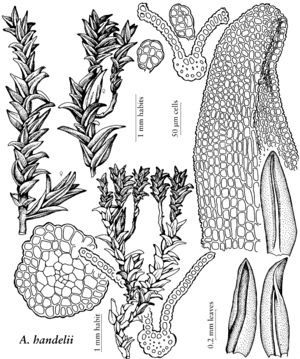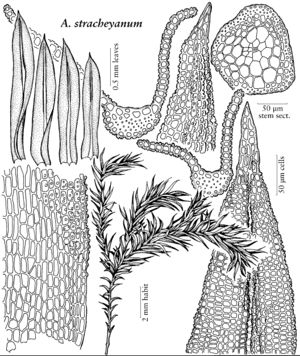Anoectangium
Sp. Musc. Frond. Suppl. 1(1): 33. 1811,.
| Taxon | Illustrator ⠉ | |
|---|---|---|
 | Anoectangium handelii | Patricia M. Eckel |
 | Anoectangium stracheyanum | Patricia M. Eckel |
Plants in turf or mats, green to yellowbrown distally, light to dark-brown proximally. Stems to 1 (–3) cm, branching occasionally; oval to rounded-triangular or pentagonal in transverse-section, hyalodermis absent, sclerodermis weak, cells with smaller lumens, but usually thin-walled, central strand present, strong; weakly radiculose or with redbrown tomentum; axillary hairs of 3–10 cells, all hyaline or basal 1–2 brownish. Leaves often distant or crowded, occasionally secund, 1–1.5 (–2) mm, appressed-incurved when dry, spreading when moist; ligulate to lanceolate, occasionally triangular or acuminate, adaxial surface strongly keeled, deeply grooved along costa; leaf base scarcely differentiated in shape or ovate, laminal margins plane or weakly recurved in proximal 1/2, entire, occasionally finely crenulate or weakly denticulate; apex broadly obtuse to sharply acute or occasionally acuminate; costa sometimes short-excurrent as a mucro or rarely ending a few cells below apex, adaxial outgrowths absent, adaxial cells elongate, occasionally shortrectangular to quadrate near apex, in 2–3 rows, abaxial cells elongate; transverse-section oval to reniform, adaxial epidermis absent to weakly developed, adaxial stereid band absent, guide cells 2–4 in 1 layer, hydroid strand absent, abaxial stereid band strong, semicircular to ovate in section, abaxial epidermis usually distinct; basal-cells differentiated in a small group at base of costa, shortrectangular, little wider than distal cells, 2–4: 1, usually thick-walled; distal medial cells subquadrate, occasionally elongate transversely or longitudinally, (5–) 7–9 (–15) µm wide, 1 (–2):1 (–2), papillae either massive, multifurcating and centered over lumens or simple to 2-fid, cell-walls thin to greatly thickened, superficially flat to bulging. Specialized asexual reproduction rare, by gemmae in axils of leaves. Sexual condition dioicous; perigonia and perichaetia terminal on short lateral branches, interior perichaetial leaves convolute-sheathing, ovate-acuminate, 1–1.5 mm, laminal cells shortly rhomboidal to near apex. Seta yellowbrown, 0.3–0.8 cm, twisted clockwise proximally, occasionally counterclockwise distally. Capsule yellowbrown to brown, ovoid to elliptic, 0.5–1 (–1.5) mm, exothecial cells rectangular, walls thin, annulus of two rows of weakly vesiculose cells; operculum long-rostrate, 0.4–0.6 (–1.8) mm, cells in straight rows; peristome teeth absent. Calyptra cucullate, 1.2–1.5 (–2) mm, smooth. Spores 9–12 (–19) µm, weakly to strongly papillose, light-brown. KOH laminal color reaction yellow to yellow-orange.
Distribution
Worldwide except Antarctica, especially tropical, arctic and montane regions
Discussion
Species 47 (3 in the flora).
Anoectangium is distinguishable from Molendoa, a morphologically similar genus also having very short perichaetia-bearing branches arranged laterally on the axis, by its often triangular stem section, constant lack of a ventral costal stereid band, the leaves keeled by a deep adaxial groove along the costa, and the nonglaucous color in nature. Hymenostylium has similarly though not as deeply keeled leaves with elongate cells on the adaxial surface, but has terminal perichaetia, lacks a stem central strand, and medial laminal cells are commonly longitudinally elongated. Amphidium species are similar in appearance but the sexual condition is autoicous (A. lapponicum) or papillae are simple and elliptical (A. mougeotii). Species of Zygodon may be distinguished by the simple, isolated papillae, not obscuring the lumens. Although the lack of an adaxial stereid band helps separate Anoectangium from robust specimens of Gymnostomum and Molendoa, variation in expression of this trait requires other traits for distinguishing small forms.
Selected References
None.
Key
| 1 | Gemmae abundant in leaf axils; leaves ligulate to short-elliptic or ovate, very short, 0.4- 0.5(-0.6) mm | Anoectangium handelii |
| 1 | Gemmae absent; leaves lanceolate to linear or nearly ligulate, longer, usually 1-2 mm | > 2 |
| 2 | Leaves distant on the stem, exposing it, short-lanceolate to nearly ligulate, not wasp-waisted; leaf apex narrowly to broadly acute, apiculus short-triangular; costa percurrent in distal leaves into a clear, sharp cell | Anoectangium aestivum |
| 2 | Leaves dense and hiding the stem, long-lanceolate to linear-elliptic, constricted above the leaf base; leaf apex narrowly acute to acuminate, apiculus narrowly triangular; costa regularly excurrent into a short or long, stout mucro of several cells. | Anoectangium stracheyanum |